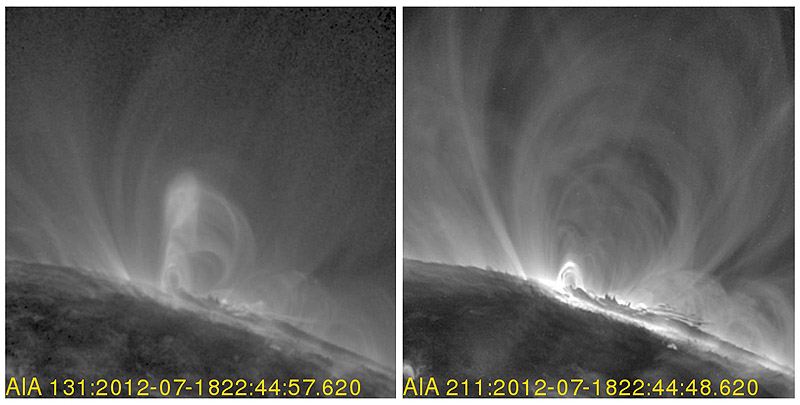By looking at the very hottest material in the sun’s atmosphere (on the left) scientists could observe the tell tale signs of the twisted magnetic fields of a flux rope – which lay at the heart of coronal mass ejections (CMEs). The flux rope doesn’t show up in a nearly simultaneous image of cooler material (on the right). These images were captured by NASA’s Solar Dynamics Observatory on July 19, 2012. (Credit: NASA/SDO)
Home By looking at the very hottest material in the sun’s atmosphere (on the left) scientists could observe the tell tale signs of the twisted magnetic fields of a flux rope – which lay at the heart of coronal mass ejections (CMEs). The flux rope doesn’t show up in a nearly simultaneous image of cooler material (on the right). These images were captured by NASA’s Solar Dynamics Observatory on July 19, 2012. (Credit: NASA/SDO) By looking at the very hottest material in the sun's atmosphere (on the left) scientists could observe the tell tale signs of the twisted magnetic fields of a flux rope – which lay at the heart of coronal mass ejections (CMEs). The flux rope doesn't show up in a nearly simultaneous image of cooler material (on the right). These images were captured by NASA's Solar Dynamics Observatory on July 19, 2012. (Credit: NASA/SDO)
By looking at the very hottest material in the sun’s atmosphere (on the left) scientists could observe the tell tale signs of the twisted magnetic fields of a flux rope – which lay at the heart of coronal mass ejections (CMEs). The flux rope doesn’t show up in a nearly simultaneous image of cooler material (on the right). These images were captured by NASA’s Solar Dynamics Observatory on July 19, 2012. (Credit: NASA/SDO)



